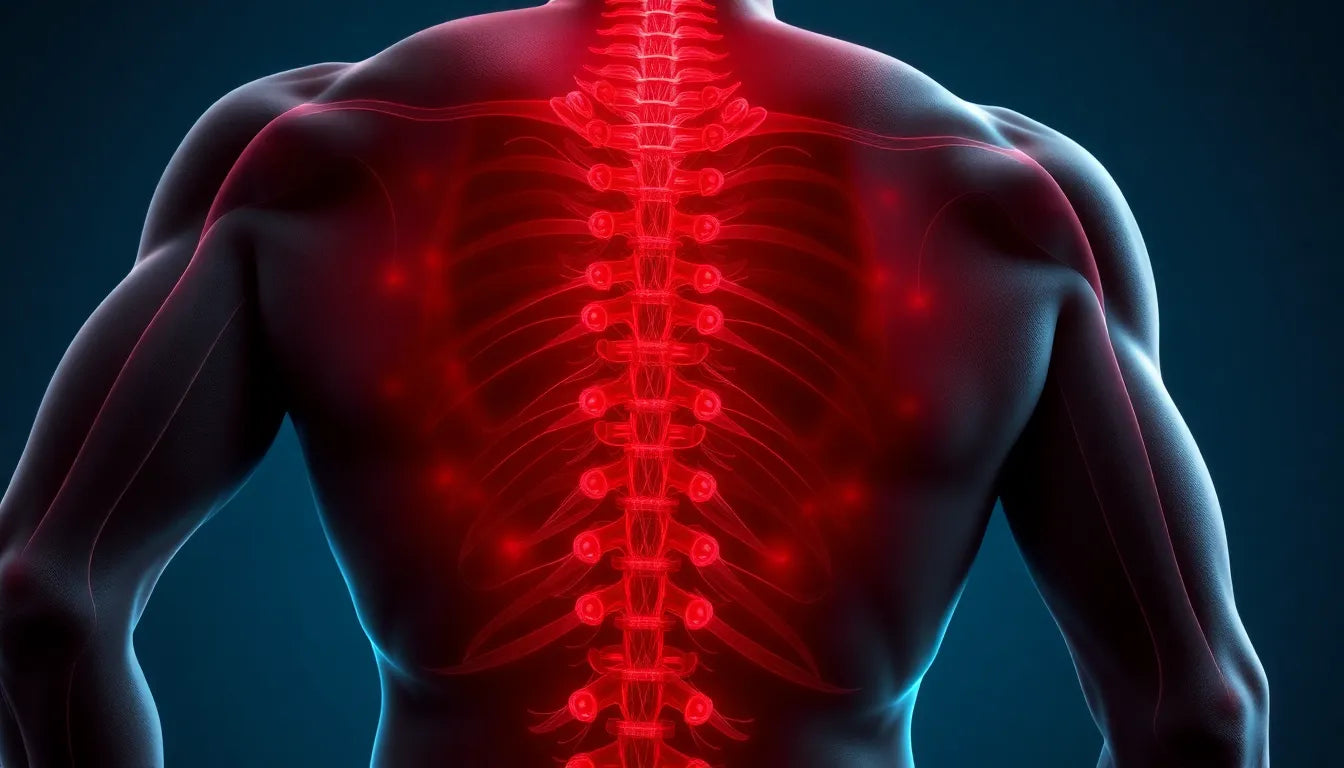When it comes to back pain, a herniated disc is often at the top of the list of culprits. But what exactly is a herniated disc, and how does it impact your daily life? Understanding these aspects is crucial for anyone dealing with this condition or trying to prevent it.
Understanding herniated discs
A herniated disc, sometimes referred to as a slipped or ruptured disc, occurs when the soft inner gel of the spinal disc pushes through a crack in the tougher exterior casing. This can lead to irritation of the surrounding nerves, resulting in pain, numbness, or weakness in an arm or leg. The condition is most common in the lower back, but it can also occur in the neck.
Several factors can contribute to the development of a herniated disc. Common causes include age-related wear and tear, known as disc degeneration, which can make the discs less flexible and more prone to tearing or rupturing with even a minor strain or twist. Risk factors such as engaging in physically demanding jobs, being overweight, or having a sedentary lifestyle can also increase the likelihood of experiencing a herniated disc. The prevalence of this condition is significant, with many people experiencing its effects at some point in their lives, impacting their ability to perform everyday activities.
The big question: can it heal naturally?
The idea of a herniated disc healing naturally is a topic of considerable interest and debate. While some people may find relief through surgical interventions, others explore the possibility of non-surgical treatments. This raises the critical question: can a herniated disc repair itself without medical intervention?
Natural healing is a process where the body attempts to repair itself without the need for surgical procedures. In the case of a herniated disc, this can involve the body's immune system gradually reducing inflammation and alleviating pain. However, the debate between surgical and non-surgical treatments is ongoing, with each approach having its proponents and critics.
Understanding your options for recovery is essential. While some individuals find that their symptoms improve over time with conservative care, others may need to consider more invasive treatments if their condition does not improve. Recognizing the potential for natural healing, alongside the importance of professional medical advice, can help you make informed decisions about your recovery journey.
Healing without surgery: expert insights
When faced with a herniated disc, many individuals wonder if surgery is the only route to relief. However, experts from the Link Neuroscience Institute suggest that a significant number of patients—up to 90%—can experience relief through conservative care. This approach emphasizes non-surgical methods such as rest, over-the-counter pain relief, and physical therapy, which can be effective in managing symptoms and promoting healing.
The body's natural response plays a crucial role in this process. According to Spine-health, the immune system can help alleviate pain by reducing the inflammation caused by the herniated disc. This natural healing mechanism, however, has its limitations. While symptoms may improve, the herniated portion of the disc may not fully return to its original state. Therefore, it's essential to balance expectations and understand the scope of natural recovery.
Exploring conservative care methods
Conservative care is often the first line of defense against the discomfort caused by a herniated disc. Rest is a fundamental component, allowing the body time to heal without the added stress of strenuous activities. However, complete inactivity is not recommended, as it can lead to muscle stiffness and weakness. Instead, modifying daily activities to avoid aggravating the condition is advised.
Heat and cold therapy can also provide symptomatic relief. Applying heat can relax tense muscles and improve blood flow, while cold therapy can reduce inflammation and numb sharp pain. These methods are simple yet effective tools in managing pain and facilitating recovery.
Physical therapy is another cornerstone of conservative treatment. Tailored exercises can strengthen the muscles supporting the spine, improve flexibility, and reduce the likelihood of future injuries. Techniques such as core stabilization exercises and gentle stretching can enhance mobility and alleviate pressure on the affected disc.
Additionally, over-the-counter pain relievers like ibuprofen or acetaminophen can help manage pain levels, allowing individuals to engage more comfortably in daily activities and rehabilitation exercises. It's important to use these medications as directed and consult with healthcare professionals to ensure they are appropriate for your specific condition.
Patient-focused approaches to healing
Education is a powerful tool in the journey to recovery. Spine-health emphasizes the importance of understanding the body's healing process and recognizing the signs of improvement. Patients who are informed about their condition are better equipped to manage their symptoms and make decisions about their care.
Knowing when to seek medical intervention is also crucial. While many herniated discs can heal with conservative treatment, there are cases where symptoms persist or worsen. In such instances, consulting with a healthcare provider is essential to explore other treatment options, including surgical interventions if necessary.
Ultimately, the path to recovery from a herniated disc is highly individual. By combining expert insights with patient-focused strategies, individuals can take proactive steps toward healing and regaining their quality of life. Understanding the potential for natural recovery, alongside the importance of professional guidance, empowers patients to navigate their journey with confidence.
Self-care strategies for herniated disc pain relief
Managing pain from a herniated disc involves a combination of strategies that can be done at home to complement medical advice. Spine-health provides valuable insights into lesser-known techniques that can aid in alleviating discomfort and promoting healing.
The McKenzie method, a series of exercises aimed at extending the spine, can help reduce disc pressure and relieve pain. This method is particularly effective in managing lumbar herniated disc symptoms. Additionally, optimizing sleep positions by using supportive pillows can help maintain spinal alignment and reduce strain during rest.
Myofascial release techniques, which involve applying gentle pressure to the connective tissues surrounding muscles, can also be beneficial. This practice helps to relieve tension and improve mobility. Hydrotherapy, or exercising in water, offers a low-impact way to strengthen muscles and improve flexibility without putting excessive strain on the spine.
Balancing hope and realism in recovery
While the prospect of natural healing is encouraging, it's important to maintain realistic expectations about the recovery timeline. Healing from a herniated disc can vary greatly among individuals, with some experiencing significant improvement within weeks, while others may take months.
Recognizing when to seek professional advice is crucial. If symptoms persist or worsen despite self-care efforts, consulting a healthcare professional is essential. They can provide guidance on whether more intensive treatments, including surgery, are necessary.
Lifestyle changes play a significant role in recovery and prevention. Maintaining a healthy weight, engaging in regular exercise, and practicing proper body mechanics can help support the healing process and prevent future occurrences.
Conclusion: navigating your recovery journey
In conclusion, while a herniated disc can be a source of significant discomfort, there are numerous conservative care options available that can aid in recovery. By understanding the body's natural healing process and implementing self-care strategies, individuals can take proactive steps toward relief.
Exploring these options with the guidance of healthcare professionals can empower you to make informed decisions about your recovery journey. Balancing hope with realism and recognizing when to seek medical intervention are key components of navigating this path effectively.
Frequently Asked Questions
How long does it take for a herniated disc to heal naturally?
The typical recovery timeline for a herniated disc can range from a few weeks to several months, depending on the severity of the condition and individual factors such as overall health and adherence to treatment plans.
What are the signs that my herniated disc is healing?
Common indicators that a herniated disc is healing include decreased pain levels, improved mobility, and the ability to engage in daily activities with less discomfort.
Should I avoid all physical activity during recovery?
Not necessarily. While it's important to avoid activities that exacerbate pain, gentle exercises and physical therapy can aid in recovery by strengthening supporting muscles and improving flexibility.
When should I consider surgery for a herniated disc?
Surgery may be considered if symptoms persist despite conservative treatment, or if significant nerve damage is present. Consulting with a healthcare professional is essential to evaluate the need for surgical intervention.
Can lifestyle changes prevent future herniated discs?
Yes, adopting lifestyle changes such as maintaining a healthy weight, engaging in regular exercise, and practicing proper body mechanics can significantly reduce the risk of future herniated discs.


















